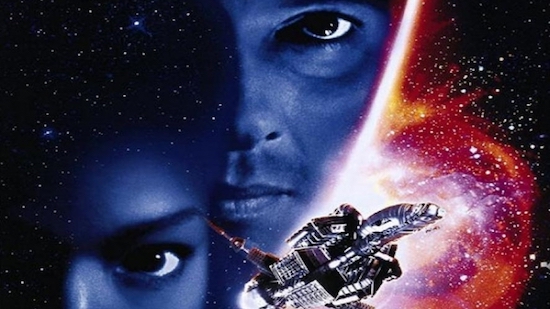Forty years ago, William Malone had an idea. It wasn’t a particularly good idea.
At the end of the 1980s, the small Australian production company Kenedy Miller had released the modestly budgeted (in Hollywood terms) thriller Dead Calm. Though initially adapted from Charles Williams’ 1963 novel of the same name, somehow during pre-production the premise had been progressively simplified until it resembled little more than a nastier, cruder version of Roman Polanski’s (1962) debut Knife In Water: a man and a woman on a boat take onboard a dangerous stranger, creating a volatile triangle of desire and simmering violence. The film was a modest commercial success but critically praised, launching the careers of international careers of director Philip Noyce and a young twenty-two year-old actress named Nicole Kidman.
A short while later, asked by producer Ash Shah to pitch something along the lines of his earlier weird Klaus Kinski-in-his-bad-days-starring sci-fi horror, Creature (1985), Malone recalled the tight, isolated set-up of Dead Calm and wondered what would happen if they stuck that boat, complete with its tense network of murderous and sexual appetites, “in space”. Never one to disguise his sources (Creature had already been a fairly transparent attempt to cash-in on the success of Alien), Malone decided to call his script “Dead Star”.
By the time that picture finally went into production, a decade later, it had been passed through the hands of at least four further writers and almost as many potential directors. It would go on to pass through several more before it finally limped to the big screen, with its budget inflating according to an inexorable logic at every stage of the game.
At one point, the film was to be a outerspace occult trip about a portal to hell discovered on a remote moon, with designs by Swiss artist H.R. Giger, the go-to man in Hollywood for anyone on the prowl for gothy sci-fi imagery with added genitals. At another stage, it was thoughtful hard science fiction to be shot by Romper Stomper’s Geoffrey Wright entirely aboard the zero gravity-simulating aircraft that NASA use for training purposes. Next it was a rough and tumble mix of blue collar grit and 1950s outerspace wonder under the aegis of Walter Hill. Next up, Jack Sholder is brought in. He “streamlined” the film, stripping out all of Hill’s complex backstories and character development and toning down the overall bleakness of the film (most notably, with regard to its ending).
Finally, the whole thing is dumped at the feet of studio board member Francis Ford Coppola who recuts the the movie in a last ditch attempt to simultaneously stay true to what he considered the original vision of Walter Hill (a director he evidently admired) and the studio’s desire to amp up the sex and tone down the special effects – to the extent of digitally blacking-up one actor (Robin Tunney) to resemble another (Angela Bassett) in order to give the latter’s character a zero-g sex scene that had never been on anyone’s shooting schedule.
In one last absurd twist, MGM then puts the results before the public with a trailer that makes it look like a dry run for Guardians of the Galaxy, all retro pop songs and coquettish one-liners.
Along the way, the picture is sold from one company to another, studios are bought and sold and restructured, people change jobs and impose old trusted collaborators on a troubled project.
Watching the film today, you find yourself faced with a bizarre palimpsest of all these things. It is like a collage of half a dozen different possible films that were never brought to fruition. The story – ultimately mangled almost to the point of incomprehension – finally ends up something not too far away from Malone’s original pitch for a Dead Calm in space. But the brute simplicity of this idea is everywhere pulled and twisted by forces pulling it in every possible other direction.
Here and there you can still see brief flashes of the sharp minds that once lent their hands: the hard-nosed, defiant characterisation built for Angela Bassett’s character with Walter Hill, the bravura, psychedelic, almost Kubrickian rapid montage sequences inserted (presumably) by Coppola whenever the space ship on which the action is set takes a “dimension jump” across the universe.
At its core, is basically an Icarus story. The handsome stranger (played by a mostly naked Peter Facinelli) picked up by the search-and-rescue ship Nightingale 229 offers the fulfilment of every desire, a jumpstart to the next stage of evolution, immortality, vast power, and a beautiful new dawn for the galaxy. Our heroes, smelling danger, set out to crush him and everything he represents. By the end of the movie, I was left wondering at what point Hollywood ceased to be a machine for the production of new desires and became instead a disciplinary mechanism for the regulation of existing desires.
But behind the overt narrative you see onscreen is a cautionary tale that reveals as much about the power struggles and machinations of the old twentieth century Hollywood, as the film’s eerie zombie-like afterlife reveals about the new movie business of the twenty-first century.
The director’s credit, after all that, was awarded to one ‘Thomas Lee’, a non-existent cipher of a man, plucked by the studio from a list of possible pseudonyms scribbled on a napkin by Walter Hill when he asked to have his name removed from the credits and ‘Alan Smithee’ – that old standby for the absentee auteur – was deemed too recognisable. In fact, in an interview for the website of the Director’s Guild of America, Hill insists that he wanted to gift the film to Smithee. “I would love to have used [the name],” he insists, “but it wasn’t one of my choices.”
It is almost as if Alan Smithee himself, a moniker once invented by the DGA to hide the shame of embarrassed directors, was himself too ashamed to be associated with the film and insisted on removing even his name from the credits.
The film tanked, naturally. Critics hated it, with the Detroit Free Press’s John Monaghan summing up the consensus that this was a “crash course from the start” and the Chicago Tribune’s John Petrakis finding only “a mission that should have been aborted long ago.” Audiences also hated it, with the box office recouping just fifteen of the estimated $90 million dollars spent on it. This is hardly surprising since, at literally every stage of the game, every single test audience that ever saw any of the many, many versions of this film, also hated it, routinely awarding it the kind of rating that – according to Sholder – is ordinarily sufficient to persuade everyone involved to “jump off a bridge”. A sobering fact to anyone dreaming of a Walter Hill “director’s cut” one day seeing the light of the day.
So why did I watch Supernova? And why am I talking about it now? Partly, as the old adage goes, ‘because it was there’. I stumbled across the unloved production somewhere in the back alleys of Netflix after an extended process of trying whatever I could to circumvent the nuisance of its homogenising recommendation algorithms. But more importantly, what is it even doing on Netflix? Who bought this turkey and why?
My guess is it ended up there in much the same way that most of the DVDs in your local charity shop ended up there. Someone dumped it. Though their licensing practices are typically inscrutable, most outside observers see the practice fairly closely resembling the kind of ‘block booking’ that got the Big Five ‘Golden Age’ studios in a whole lot of anti-trust trouble back in the 1940s. As a result, if you look past what’s “Trending Now” and “Popular on Netflix”, you soon find yourself wading through a bizarre cinematic graveyard which can be a telling barometer of whatever’s currently out of favour.
The last few months, for instance, ever since his child abuse allegations have been back in the press, significant quantities of Woody Allen product have been turning up on the streaming service. Post-MeToo, the Netflix search bar throws up an uncanny number of hits for other alleged abusers like James Woods, Sylvestor Stallone, Bryan Singer, and Oliver Stone. Likewise, the appearance of a film called Wanted, starring James McAvoy as a frustrated nobody who finds self-actualisation when he walks into his workplace-slash-educational institution with a bunch of semi-automatic weapons and violently murders everyone in sight, and ends with an urgent voice over instructing viewers to “take control”. After Elliott Rodger, Alek Minassian et al, the film feels uncomfortably like a manifesto for mass murder.
When scandal strikes, streaming services – placed in the uncomfortable and unwanted position of publishers with a presumed editorial responsibility – may naturally be inclined towards the deft removal of offensive content. But the appearance of censorship can draw attention when attention is exactly what had hoped to be avoided. Spotify’s ill-fate ‘hate content’ that saw them removing tracks by R Kelly and XXXTentacion before hurriedly re-instating them after a huge public backlash, is a case in point. Far better, perhaps, not to remove but simply bury within a crowd. Netflix’s near-impossible-to-navigate user interface provides the perfect environment in which to hide a rotten film – like Poe’s purloined letter – in plain sight.
Supernova is available on demand via Netflix



